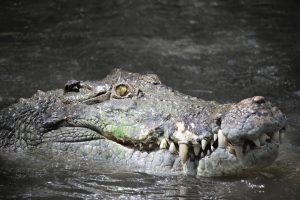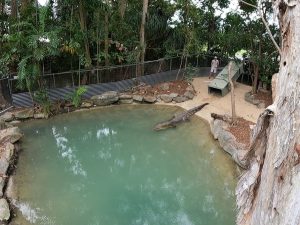It is no wonder everyone who comes to Australia wants a koala photo! Internationally, the koala, is Australia’s most recognised animal. Amazingly cute, mysterious and quite unique in its looks, the koala has a famous reputation for many reasons.

Koala Photo
We are quite lucky at Wildlife Habitat, being one of the few places in the world where our guests are allowed to hold the koala during the souvenir photo experience.
It is an experience we enjoy; it is not often you are blessed with a job where you make dreams come true! We love to see the smiles on the faces of visitors when they first feel the soft fur and smell the delicious eucalyptus scent. Souvenir photos with our resident koalas are available 4 times throughout the day.
Koala’s do have a great union though. They are only allowed to work 30 minutes a day, 3 days in a row. They need the other 23.5 hours to do important work – like sleeping, eating and digesting their food. Hence, the cuddle is quick, the souvenir photo is your lasting memory of this special moment.
To spend more interactive time with one of our resident koalas, we suggest you opt for our private tour YOUR Wildlife Habitat, with opportunities to interact with the koala in its enclosure under the supervision of your Wildlife Keeper guide.

Common misnomers about koala bears….
- They are not a bear; they are a marsupial. However, 200 years ago European settlers had never seen a marsupial and did not know about pouched animals. The bear was the closet mammal the koala looked like.
- They are not drunk or stoned! Their food is high in fibre, 50% water and also contains tannins, fats, starch protein and minerals.
- They do not sleep because they are lazy; their bodies are resting but internally working hard to digest their food.
- Yes, they are a cute animal but remember they have 1 inch claws for climbing trees!

Conservation Status
The Queensland Koala is listed as Vulnerable on the Australian Environment Protection and Biodiversity Conservation Act 1999 threatened species list.
In May 2015, the Queensland Department of Environment and Heritage Protection decided to list the Queensland Koala as vulnerable in the state; federally it was listed in 2012.
By raising the status of the Queensland Koala, the QLD and Federal governments, are ensuring there are necessary plans and schemes in place to ensure the koala remains with us and is not lost forever like the Tasmanian Tiger.
Main threats:
- Habitat fragmentation – roads being built within a koala’s territory
- Domestic animals – cats and dogs
- Loss of habitat – urbanisation, farming and deforestation
- Chlamydia – stress related due to conservation issues, easily spread through touch
- Bushfires
There are many national and local area ‘Save the Koala’ conservation groups where you can contribute funds or your time towards the conservation of the koala.

Interesting koala facts:
- Koalas have 2 thumbs on each hand for gripping when climbing and grasping food – and for holding on tight when you are getting a Koala Cuddle!
- Koala’s have 2 fused toes on each foot for grooming.
- They have a very good sense of smell. They are territorial animals; males utilise scent marking to deter other males from their territory. They also use their sense of smell to determine the levels of toxins in eucalyptus leaves for eating.
- Their enlarged ears are great at hearing. Most of their activity is nocturnal and koala’s cannot see very well at night. Their hearing therefore allows them to determine if predators are nearby before they begin their nightly adventures and also lets them know if there are other koalas about.
- They have a plated bottom, just like their cousin the wombat. The wombat however, uses its plated bottom for protection or to seal its burrow. The koala uses its plated bottom as a built in pillow for perching safely for long periods in trees.
- Of over 600 types of eucalyptus trees, koalas eat only 150 species. Contrary to popular belief they do not absorb the toxins and get ‘stoned’. They need to eat lots of leaves to get their necessary energy.
- Each koala eats approx. 500g of leaf per day, they prefer the soft new tips of the eucalyptus leaf, as it contains the most nutrients and requires less chewing.
- Many centuries ago indigenous tribes use to eat some parts of the koala and it is featured in many Dreamtime legends.
- It is estimated more than 2 million koalas were hunted prior to 1924 and in one month in 1927 over 600,000 were killed for their pelts.
- Koalas probably evolved on the Australian continent when it was separating from Antarctica, with koala-like fossils being found dated 25 million years ago.
- There has been much scientific debate over whether northern and southern koala’s are separate sub-species due to their subtle differences in appearance. However, recent DNA research shows no clear differences.

Breeding
Breeding occurs during summer, most females only produce one joey per year. The gestation period in the womb is very short – about 35 days. The joey will make its way to the pouch attaching to the mother’s nipple. They will remain in the pouch for up to 8 months.
During weaning, the joey will be feed on partially digested eucalyptus leaf called ‘pap’ that comes from the mother’s digestive system, but it is not poo! In the pap the mother passes on micro-organisms which will allow the joey to eat eucalyptus leaves.
Our sister zoo Rainforestation Nature Park in Kuranda has an active koala breeding program and welcomed 3 koala joeys into our koala population last year. Including little BonBon, who is without a doubt the cutest koala joey born in 2015! Koala cuddles are also available throughout the day at our sister zoos Rainforestation Nature Park and Cairns ZOOM and Wildlife Dome.

Making dreams come true – the best time to see a koala!
The best time to see our koala’s is during our Feature Creature or Koala Souvenir Photo times, or during our 2.40pm Daily Koala feeding presentation. Everyone wakes up for food!
We understand the Koala Cuddle experience is very important to all our guests and we endeavour to do everything to make this moment special. We welcome you to share your memories on our Facebook page.










